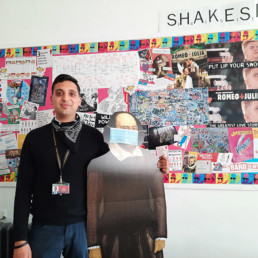
Written by Gaurav Dubay
Head of English at King Edwards VI Handsworth Grammar School for Boys and Evidence Lead in Education.
The need to diversify
In 2010, the then Education Secretary, Michael Gove, announced a number of sweeping educational reforms – particularly in English – where the likes of Byron, Keats and Dickens would firmly be re-rooted and restored to their original veneration within the English educational system. The changes were designed to bring rigour and improve students’ grasp of English Language and Literature. Whilst I firmly welcomed the ambitions, I feared that the texts I loved – ‘To Kill a Mockingbird’, ‘All My Sons’ and ‘Shards of Memory’ – would be relegated to the lower leagues of what I like to call The Reading League, and thus deny countless students access to texts that they could both learn from and relate to.
Since that time, my suspicions have been confirmed by countless reports, and, most recently, The National Literacy Trust concluded that the majority of ethnic minority students do not ‘see themselves in what they read’ (Best et al, 2020). The findings of reports like the one aforementioned, as well as our own internal evidence, meant that we – in a multi-ethnic school – needed to work on developing curriculum diversity. The words of Fletcher (2005) resonated with us where the assertion is made that learners’ voice creates ‘empathetic learning environments that value diversity and multiple perspectives.’ We made the choice, therefore, to put our students at the forefront of the discussion on curriculum diversity.
What did our pupil voice dialogue look like?
MHS (Mentally Healthy Schools) argues pupil voice is an effective mechanism through which we ‘can create meaningful change…better academic outcomes’ and perhaps most importantly facilitates ‘a sense of empowerment and inclusion’. There is a wealth of information we can refer to in order to successfully implement pupil voice. However, we strongly felt that we needed our students to feel a sense of ‘empowerment’ through the process. We, therefore, framed our discussion using the following format:
- Explored, discussed and defined the meaning of diversity.
- Explored what worked well in our curriculum.
- Explored what didn’t work well.
- Develop pragmatic solutions.
Finally, in order to value all voices, students were chosen to contribute through randomised selection.
The outcomes of the discussion:
- Defining diversity – It was clear from the onset that our students believed that the celebration of our unique identities – race, religion and gender – was to feature as part of our definition. However, there was a growing sense, through the process, that uniqueness and equality could not be separated; each unique experience needed to be equally understood and equally valued. To that end, our students phrased our department’s diversity vision as ‘An acceptance, recognition and celebration of our unique identities. Each unique experience – regardless of race, religion, sexuality and the like – are to be celebrated. No voice will be silenced and all voices will be respected.’ Perhaps the most enlightening experience was the unanimous feeling that the word ‘tolerance’ was not to feature as part of the definition.
- WWW – Students strongly agreed that the curriculum, particularly at Key Stage 3, exposed them to diverse voices. One student felt he would have ‘been none the wiser about the tensions traditional African women face had it not have been for The No1 Ladies’ Detective Agency’. Others appreciated the opportunity to discuss topical issues with regards to race through their study of transactional writing in year 11 and ‘Othello’ in Sixth Form.
- HTD – The discussion did, however, expose flaws that need addressing. Whilst the success of English learning lies in the variegating offerings of texts and genres studied, it was strongly felt that the discussion needed to extend beyond the English curriculum and many confirmed the findings of Johnson (2010) who felt that diversity broadens beyond the school curriculum and needs to be part of a school’s ethos. Our pupils also felt more needed to be done to ‘educate’ – not ‘punish’ – those who ‘might get it wrong’.
- Feeding in to our DDP – The findings of our discussion have since been implemented in to our DDP (see https://www.handsworth.bham.sch.uk/curriculum/subjects/english/). It will be our students, however, who will be tasked with evaluating our effectiveness and they, too, will play an important role in successfully building a diverse curriculum that regularly seeks to explore the voices of those who are often marginalised.
- Wider school – following the findings, students will discuss their findings further with the School Council.
What we learnt:
Time! This is perhaps the most important lesson we learnt as a leadership team. Discussions about diversity cannot simply be timetabled and forgotten about. We needed to extend our discussion not once, not twice, but three times (and if we could have discussed more, we would)! There was a lot that needed to be said, digested and explored.
Personally, however, I felt that our students would not come up with solutions that were pragmatic. I was well and truly proven wrong! Solutions were not only pragmatic, but insightful, empathetic and empowering. TP Due argues, ‘Diversity should just be called reality. Your books, your TV shows, your movies, your articles, your curricula need to reflect reality.’ We are not there yet – but we are on a journey to get there.
For further information, please follow us @english_hgs
Personal Twitter handle: @GauravDubay3
Bibliography:
- Best, Clark and Picton, I. (2020). ‘Seeing Yourself in What you Read: Diversity and Children and Young People’s Reading in 2020’. NLT – UK.
- Fletcher, A (2005). Meaningful Student Involvement: Guide to students as partners in school change. Soundout www.soundout.org/MSIGuide.pdf
- Johnson, LS (2010). ‘The Diversity Imperative: Building a culturally responsive school ethos’. Intercultural Education. 14. p 17 – 30.
- Mentally Healthy Schools: https://www.mentallyhealthyschools.org.uk/

